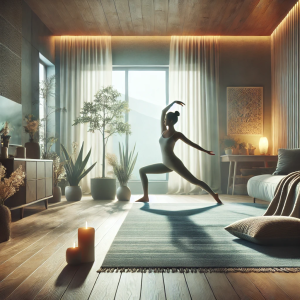By: Dr. Maya Singh, Chakra Healer and Sexual Wellness Expert
Flexibility is a key component of physical fitness and overall well-being. Incorporating yoga into your routine can significantly improve flexibility, enhance physical performance, and promote mental and emotional balance. Yoga offers a holistic approach to flexibility by combining physical postures, breath control, and mindfulness. This article explores the principles, benefits, and practices of yoga for flexibility, providing insights into how you can integrate them into your life for improved health and well-being.

Understanding the Role of Yoga in Improving Flexibility
Yoga is a practice that harmonizes the mind, body, and spirit. It involves a series of physical postures (asanas) that stretch and strengthen muscles, tendons, and ligaments, improving flexibility and range of motion. By focusing on the present moment and creating a sense of mindfulness, yoga helps to release tension and promote relaxation, making it easier to achieve and maintain flexibility.

Key Yoga Techniques for Flexibility
- Asanas (Physical Postures): Certain yoga postures are particularly effective in improving flexibility. These poses help to stretch and lengthen muscles, increase range of motion, and promote a sense of well-being. Common flexibility-enhancing asanas include:
- Pigeon Pose (Eka Pada Rajakapotasana): This deep hip opener stretches the hip flexors, glutes, and lower back, promoting flexibility in the hips and lower body.
- Forward Fold (Uttanasana): This pose stretches the hamstrings, calves, and lower back, improving flexibility in the posterior chain.
- Bridge Pose (Setu Bandhasana): This pose stretches the chest, neck, and spine, promoting flexibility in the upper body.
- Cobra Pose (Bhujangasana): This backbend stretches the spine, chest, and shoulders, enhancing flexibility in the back and upper body.

- Dynamic Stretching: Dynamic stretching involves moving through a range of motion to prepare the muscles for activity. Incorporating dynamic stretches into your yoga practice can improve flexibility and prevent injury. Examples include:
- Sun Salutations (Surya Namaskar): This sequence of poses flows from one to the next, warming up the muscles and increasing flexibility.
- Cat-Cow Pose (Marjaryasana-Bitilasana): This gentle flow between two poses helps to increase flexibility in the spine and promote mobility.
- Static Stretching: Static stretching involves holding a stretch for an extended period, allowing the muscles to lengthen and relax. Incorporating static stretches into your yoga practice can improve flexibility and promote relaxation. Examples include:
- Seated Forward Bend (Paschimottanasana): This pose involves sitting with the legs extended and reaching forward, stretching the hamstrings and lower back.
- Butterfly Pose (Baddha Konasana): This pose involves sitting with the soles of the feet together and gently pressing the knees towards the floor, stretching the inner thighs and hips.

- Pranayama (Breath Control): Breath control techniques are a fundamental aspect of yoga for flexibility. By regulating the breath, you can enhance relaxation and improve flexibility. Effective pranayama techniques include:
- Deep Belly Breathing: This technique involves taking slow, deep breaths into the belly, which activates the relaxation response and promotes flexibility.
- Alternate Nostril Breathing (Nadi Shodhana): This balancing breath technique helps to harmonize the left and right hemispheres of the brain, promoting a sense of calm and balance.
- Mindfulness and Meditation: Mindfulness and meditation are powerful tools for improving flexibility. By focusing the mind and eliminating distractions, you can achieve a state of deep relaxation and inner peace, making it easier to stretch and lengthen muscles. Common meditation techniques for flexibility include:
- Body Scan: This meditation technique involves mentally scanning the body for areas of tension and consciously relaxing them.
- Guided Visualization: This technique involves visualizing a peaceful scene or setting to promote relaxation and reduce stress.

The Benefits of Yoga for Flexibility
- Improved Physical Performance: Increased flexibility enhances physical performance by improving range of motion, reducing the risk of injury, and promoting better posture and alignment.
- Enhanced Mental Clarity: The combination of physical postures, breath control, and mindfulness in yoga promotes mental clarity and concentration, helping to reduce mental clutter and improve focus.
- Emotional Balance: Yoga supports emotional well-being by releasing tension and stress, fostering mindfulness, and cultivating self-awareness.
- Stress Relief: The relaxation techniques and breathing exercises in yoga are effective in reducing stress and anxiety. They activate the parasympathetic nervous system, promoting a state of calm and relaxation.
- Spiritual Growth: Yoga provides a pathway to spiritual growth by fostering a deeper connection with the self and the universe. The practice encourages introspection, self-discovery, and a sense of unity with the divine.

Incorporating Yoga for Flexibility into Your Daily Routine
To fully benefit from yoga for flexibility, it is important to incorporate it into your daily routine. Here are some tips to get started:
- Create a Calm Space: Designate a quiet and peaceful area in your home for your yoga practice. This space can include a yoga mat, props (like blocks and straps), and items that inspire you, such as candles, crystals, and soothing music.
- Set a Regular Practice Time: Establish a consistent time each day for your yoga practice. Morning or evening sessions are ideal for setting a positive tone for the day or unwinding before sleep.
- Start with Simple Poses: Begin with simple and accessible poses, gradually progressing to more challenging asanas as your practice evolves. Focus on alignment and breath control in each pose.
- Include Dynamic and Static Stretching: Incorporate both dynamic and static stretches into your practice to improve flexibility and prevent injury. Spend a few minutes on dynamic stretches to warm up the muscles before moving into static stretches.
- End with Relaxation: Always conclude your practice with a relaxation pose, such as Savasana. This allows the body and mind to integrate the benefits of the practice and promotes a sense of peace and well-being.

Combining Yoga with Other Flexibility Practices
Yoga can be seamlessly integrated with other flexibility practices to enhance its benefits:
- Pilates: Combining yoga with Pilates can improve core strength and flexibility, promoting better posture and alignment.
- Dance: Dance classes, such as ballet or contemporary dance, can complement your yoga practice by improving flexibility and promoting fluid movement.
- Strength Training: Incorporating strength training exercises into your routine can support your yoga practice by enhancing muscle tone and preventing injury.
- Massage Therapy: Regular massage therapy can complement your yoga practice by relieving muscle tension and promoting relaxation.
Conclusion
Yoga is a powerful tool for improving flexibility, offering a holistic approach to stretching and strengthening the body. By incorporating yoga into your daily routine, you can experience the transformative benefits of this ancient practice, including increased flexibility, enhanced physical performance, improved mental clarity, and emotional balance. Whether you are a beginner or an experienced practitioner, yoga provides a pathway to stretching your limits and achieving greater well-being.
Dr. Maya Singh is a distinguished chakra healer and sexual wellness expert with a Ph.D. in Holistic Health Sciences. With over 20 years of experience in energy healing, she specializes in aligning the body's chakras to improve overall well-being and enhance sexual energy. Dr. Singh conducts workshops and private sessions, focusing on the interplay between chakra balance and sexual intimacy. Her holistic approach integrates ancient chakra wisdom with modern sexual health practices to help individuals and couples achieve deeper connections and heightened intimacy.


